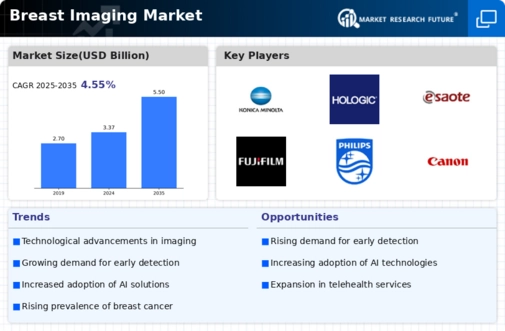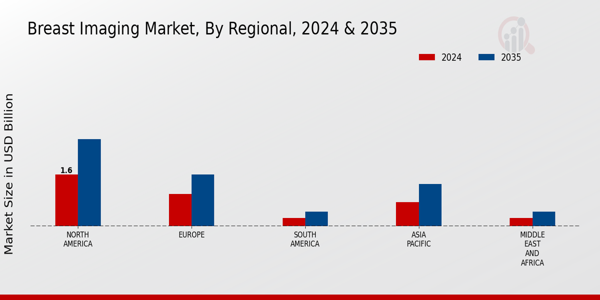Mammography
Ultrasound
Magnetic Resonance Imaging
Tomosynthesis
Breast Biopsy
Systems
Consumables
Software
Screening
Diagnosis
Treatment Planning
Hospitals
Diagnostic Centers
Research Institutes
North America
Europe
South America
Asia Pacific
Middle East and Africa
North America Outlook (USD Billion, 2019-2035)
North America Breast Imaging Market by Technology Type
Mammography
Ultrasound
Magnetic Resonance Imaging
Tomosynthesis
Breast Biopsy
North America Breast Imaging Market by Product Type
Systems
Consumables
Software
North America Breast Imaging Market by Application Type
Screening
Diagnosis
Treatment Planning
North America Breast Imaging Market by End Use Type
Hospitals
Diagnostic Centers
Research Institutes
North America Breast Imaging Market by Regional Type
US
Canada
US Outlook (USD Billion, 2019-2035)
US Breast Imaging Market by Technology Type
Mammography
Ultrasound
Magnetic Resonance Imaging
Tomosynthesis
Breast Biopsy
US Breast Imaging Market by Product Type
Systems
Consumables
Software
US Breast Imaging Market by Application Type
Screening
Diagnosis
Treatment Planning
US Breast Imaging Market by End Use Type
Hospitals
Diagnostic Centers
Research Institutes
CANADA Outlook (USD Billion, 2019-2035)
CANADA Breast Imaging Market by Technology Type
Mammography
Ultrasound
Magnetic Resonance Imaging
Tomosynthesis
Breast Biopsy
CANADA Breast Imaging Market by Product Type
Systems
Consumables
Software
CANADA Breast Imaging Market by Application Type
Screening
Diagnosis
Treatment Planning
CANADA Breast Imaging Market by End Use Type
Hospitals
Diagnostic Centers
Research Institutes
Europe Outlook (USD Billion, 2019-2035)
Europe Breast Imaging Market by Technology Type
Mammography
Ultrasound
Magnetic Resonance Imaging
Tomosynthesis
Breast Biopsy
Europe Breast Imaging Market by Product Type
Systems
Consumables
Software
Europe Breast Imaging Market by Application Type
Screening
Diagnosis
Treatment Planning
Europe Breast Imaging Market by End Use Type
Hospitals
Diagnostic Centers
Research Institutes
Europe Breast Imaging Market by Regional Type
Germany
UK
France
Russia
Italy
Spain
Rest of Europe
GERMANY Outlook (USD Billion, 2019-2035)
GERMANY Breast Imaging Market by Technology Type
Mammography
Ultrasound
Magnetic Resonance Imaging
Tomosynthesis
Breast Biopsy
GERMANY Breast Imaging Market by Product Type
Systems
Consumables
Software
GERMANY Breast Imaging Market by Application Type
Screening
Diagnosis
Treatment Planning
GERMANY Breast Imaging Market by End Use Type
Hospitals
Diagnostic Centers
Research Institutes
UK Outlook (USD Billion, 2019-2035)
UK Breast Imaging Market by Technology Type
Mammography
Ultrasound
Magnetic Resonance Imaging
Tomosynthesis
Breast Biopsy
UK Breast Imaging Market by Product Type
Systems
Consumables
Software
UK Breast Imaging Market by Application Type
Screening
Diagnosis
Treatment Planning
UK Breast Imaging Market by End Use Type
Hospitals
Diagnostic Centers
Research Institutes
FRANCE Outlook (USD Billion, 2019-2035)
FRANCE Breast Imaging Market by Technology Type
Mammography
Ultrasound
Magnetic Resonance Imaging
Tomosynthesis
Breast Biopsy
FRANCE Breast Imaging Market by Product Type
Systems
Consumables
Software
FRANCE Breast Imaging Market by Application Type
Screening
Diagnosis
Treatment Planning
FRANCE Breast Imaging Market by End Use Type
Hospitals
Diagnostic Centers
Research Institutes
RUSSIA Outlook (USD Billion, 2019-2035)
RUSSIA Breast Imaging Market by Technology Type
Mammography
Ultrasound
Magnetic Resonance Imaging
Tomosynthesis
Breast Biopsy
RUSSIA Breast Imaging Market by Product Type
Systems
Consumables
Software
RUSSIA Breast Imaging Market by Application Type
Screening
Diagnosis
Treatment Planning
RUSSIA Breast Imaging Market by End Use Type
Hospitals
Diagnostic Centers
Research Institutes
ITALY Outlook (USD Billion, 2019-2035)
ITALY Breast Imaging Market by Technology Type
Mammography
Ultrasound
Magnetic Resonance Imaging
Tomosynthesis
Breast Biopsy
ITALY Breast Imaging Market by Product Type
Systems
Consumables
Software
ITALY Breast Imaging Market by Application Type
Screening
Diagnosis
Treatment Planning
ITALY Breast Imaging Market by End Use Type
Hospitals
Diagnostic Centers
Research Institutes
SPAIN Outlook (USD Billion, 2019-2035)
SPAIN Breast Imaging Market by Technology Type
Mammography
Ultrasound
Magnetic Resonance Imaging
Tomosynthesis
Breast Biopsy
SPAIN Breast Imaging Market by Product Type
Systems
Consumables
Software
SPAIN Breast Imaging Market by Application Type
Screening
Diagnosis
Treatment Planning
SPAIN Breast Imaging Market by End Use Type
Hospitals
Diagnostic Centers
Research Institutes
REST OF EUROPE Outlook (USD Billion, 2019-2035)
REST OF EUROPE Breast Imaging Market by Technology Type
Mammography
Ultrasound
Magnetic Resonance Imaging
Tomosynthesis
Breast Biopsy
REST OF EUROPE Breast Imaging Market by Product Type
Systems
Consumables
Software
REST OF EUROPE Breast Imaging Market by Application Type
Screening
Diagnosis
Treatment Planning
REST OF EUROPE Breast Imaging Market by End Use Type
Hospitals
Diagnostic Centers
Research Institutes
APAC Outlook (USD Billion, 2019-2035)
APAC Breast Imaging Market by Technology Type
Mammography
Ultrasound
Magnetic Resonance Imaging
Tomosynthesis
Breast Biopsy
APAC Breast Imaging Market by Product Type
Systems
Consumables
Software
APAC Breast Imaging Market by Application Type
Screening
Diagnosis
Treatment Planning
APAC Breast Imaging Market by End Use Type
Hospitals
Diagnostic Centers
Research Institutes
APAC Breast Imaging Market by Regional Type
China
India
Japan
South Korea
Malaysia
Thailand
Indonesia
Rest of APAC
CHINA Outlook (USD Billion, 2019-2035)
CHINA Breast Imaging Market by Technology Type
Mammography
Ultrasound
Magnetic Resonance Imaging
Tomosynthesis
Breast Biopsy
CHINA Breast Imaging Market by Product Type
Systems
Consumables
Software
CHINA Breast Imaging Market by Application Type
Screening
Diagnosis
Treatment Planning
CHINA Breast Imaging Market by End Use Type
Hospitals
Diagnostic Centers
Research Institutes
INDIA Outlook (USD Billion, 2019-2035)
INDIA Breast Imaging Market by Technology Type
Mammography
Ultrasound
Magnetic Resonance Imaging
Tomosynthesis
Breast Biopsy
INDIA Breast Imaging Market by Product Type
Systems
Consumables
Software
INDIA Breast Imaging Market by Application Type
Screening
Diagnosis
Treatment Planning
INDIA Breast Imaging Market by End Use Type
Hospitals
Diagnostic Centers
Research Institutes
JAPAN Outlook (USD Billion, 2019-2035)
JAPAN Breast Imaging Market by Technology Type
Mammography
Ultrasound
Magnetic Resonance Imaging
Tomosynthesis
Breast Biopsy
JAPAN Breast Imaging Market by Product Type
Systems
Consumables
Software
JAPAN Breast Imaging Market by Application Type
Screening
Diagnosis
Treatment Planning
JAPAN Breast Imaging Market by End Use Type
Hospitals
Diagnostic Centers
Research Institutes
SOUTH KOREA Outlook (USD Billion, 2019-2035)
SOUTH KOREA Breast Imaging Market by Technology Type
Mammography
Ultrasound
Magnetic Resonance Imaging
Tomosynthesis
Breast Biopsy
SOUTH KOREA Breast Imaging Market by Product Type
Systems
Consumables
Software
SOUTH KOREA Breast Imaging Market by Application Type
Screening
Diagnosis
Treatment Planning
SOUTH KOREA Breast Imaging Market by End Use Type
Hospitals
Diagnostic Centers
Research Institutes
MALAYSIA Outlook (USD Billion, 2019-2035)
MALAYSIA Breast Imaging Market by Technology Type
Mammography
Ultrasound
Magnetic Resonance Imaging
Tomosynthesis
Breast Biopsy
MALAYSIA Breast Imaging Market by Product Type
Systems
Consumables
Software
MALAYSIA Breast Imaging Market by Application Type
Screening
Diagnosis
Treatment Planning
MALAYSIA Breast Imaging Market by End Use Type
Hospitals
Diagnostic Centers
Research Institutes
THAILAND Outlook (USD Billion, 2019-2035)
THAILAND Breast Imaging Market by Technology Type
Mammography
Ultrasound
Magnetic Resonance Imaging
Tomosynthesis
Breast Biopsy
THAILAND Breast Imaging Market by Product Type
Systems
Consumables
Software
THAILAND Breast Imaging Market by Application Type
Screening
Diagnosis
Treatment Planning
THAILAND Breast Imaging Market by End Use Type
Hospitals
Diagnostic Centers
Research Institutes
INDONESIA Outlook (USD Billion, 2019-2035)
INDONESIA Breast Imaging Market by Technology Type
Mammography
Ultrasound
Magnetic Resonance Imaging
Tomosynthesis
Breast Biopsy
INDONESIA Breast Imaging Market by Product Type
Systems
Consumables
Software
INDONESIA Breast Imaging Market by Application Type
Screening
Diagnosis
Treatment Planning
INDONESIA Breast Imaging Market by End Use Type
Hospitals
Diagnostic Centers
Research Institutes
REST OF APAC Outlook (USD Billion, 2019-2035)
REST OF APAC Breast Imaging Market by Technology Type
Mammography
Ultrasound
Magnetic Resonance Imaging
Tomosynthesis
Breast Biopsy
REST OF APAC Breast Imaging Market by Product Type
Systems
Consumables
Software
REST OF APAC Breast Imaging Market by Application Type
Screening
Diagnosis
Treatment Planning
REST OF APAC Breast Imaging Market by End Use Type
Hospitals
Diagnostic Centers
Research Institutes
South America Outlook (USD Billion, 2019-2035)
South America Breast Imaging Market by Technology Type
Mammography
Ultrasound
Magnetic Resonance Imaging
Tomosynthesis
Breast Biopsy
South America Breast Imaging Market by Product Type
Systems
Consumables
Software
South America Breast Imaging Market by Application Type
Screening
Diagnosis
Treatment Planning
South America Breast Imaging Market by End Use Type
Hospitals
Diagnostic Centers
Research Institutes
South America Breast Imaging Market by Regional Type
Brazil
Mexico
Argentina
Rest of South America
BRAZIL Outlook (USD Billion, 2019-2035)
BRAZIL Breast Imaging Market by Technology Type
Mammography
Ultrasound
Magnetic Resonance Imaging
Tomosynthesis
Breast Biopsy
BRAZIL Breast Imaging Market by Product Type
Systems
Consumables
Software
BRAZIL Breast Imaging Market by Application Type
Screening
Diagnosis
Treatment Planning
BRAZIL Breast Imaging Market by End Use Type
Hospitals
Diagnostic Centers
Research Institutes
MEXICO Outlook (USD Billion, 2019-2035)
MEXICO Breast Imaging Market by Technology Type
Mammography
Ultrasound
Magnetic Resonance Imaging
Tomosynthesis
Breast Biopsy
MEXICO Breast Imaging Market by Product Type
Systems
Consumables
Software
MEXICO Breast Imaging Market by Application Type
Screening
Diagnosis
Treatment Planning
MEXICO Breast Imaging Market by End Use Type
Hospitals
Diagnostic Centers
Research Institutes
ARGENTINA Outlook (USD Billion, 2019-2035)
ARGENTINA Breast Imaging Market by Technology Type
Mammography
Ultrasound
Magnetic Resonance Imaging
Tomosynthesis
Breast Biopsy
ARGENTINA Breast Imaging Market by Product Type
Systems
Consumables
Software
ARGENTINA Breast Imaging Market by Application Type
Screening
Diagnosis
Treatment Planning
ARGENTINA Breast Imaging Market by End Use Type
Hospitals
Diagnostic Centers
Research Institutes
REST OF SOUTH AMERICA Outlook (USD Billion, 2019-2035)
REST OF SOUTH AMERICA Breast Imaging Market by Technology Type
Mammography
Ultrasound
Magnetic Resonance Imaging
Tomosynthesis
Breast Biopsy
REST OF SOUTH AMERICA Breast Imaging Market by Product Type
Systems
Consumables
Software
REST OF SOUTH AMERICA Breast Imaging Market by Application Type
Screening
Diagnosis
Treatment Planning
REST OF SOUTH AMERICA Breast Imaging Market by End Use Type
Hospitals
Diagnostic Centers
Research Institutes
MEA Outlook (USD Billion, 2019-2035)
MEA Breast Imaging Market by Technology Type
Mammography
Ultrasound
Magnetic Resonance Imaging
Tomosynthesis
Breast Biopsy
MEA Breast Imaging Market by Product Type
Systems
Consumables
Software
MEA Breast Imaging Market by Application Type
Screening
Diagnosis
Treatment Planning
MEA Breast Imaging Market by End Use Type
Hospitals
Diagnostic Centers
Research Institutes
MEA Breast Imaging Market by Regional Type
GCC Countries
South Africa
Rest of MEA
GCC COUNTRIES Outlook (USD Billion, 2019-2035)
GCC COUNTRIES Breast Imaging Market by Technology Type
Mammography
Ultrasound
Magnetic Resonance Imaging
Tomosynthesis
Breast Biopsy
GCC COUNTRIES Breast Imaging Market by Product Type
Systems
Consumables
Software
GCC COUNTRIES Breast Imaging Market by Application Type
Screening
Diagnosis
Treatment Planning
GCC COUNTRIES Breast Imaging Market by End Use Type
Hospitals
Diagnostic Centers
Research Institutes
SOUTH AFRICA Outlook (USD Billion, 2019-2035)
SOUTH AFRICA Breast Imaging Market by Technology Type
Mammography
Ultrasound
Magnetic Resonance Imaging
Tomosynthesis
Breast Biopsy
SOUTH AFRICA Breast Imaging Market by Product Type
Systems
Consumables
Software
SOUTH AFRICA Breast Imaging Market by Application Type
Screening
Diagnosis
Treatment Planning
SOUTH AFRICA Breast Imaging Market by End Use Type
Hospitals
Diagnostic Centers
Research Institutes
REST OF MEA Outlook (USD Billion, 2019-2035)
REST OF MEA Breast Imaging Market by Technology Type
Mammography
Ultrasound
Magnetic Resonance Imaging
Tomosynthesis
Breast Biopsy
REST OF MEA Breast Imaging Market by Product Type
Systems
Consumables
Software
REST OF MEA Breast Imaging Market by Application Type
Screening
Diagnosis
Treatment Planning
REST OF MEA Breast Imaging Market by End Use Type
Hospitals
Diagnostic Centers
Research Institutes












Leave a Comment